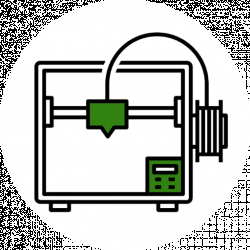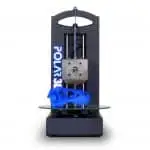- Creality Ender vs Anet A8 [2022]: Which is Better? - April 14, 2022
- TEVO Tornado Review [2022] All You Need To Know - April 6, 2022
- Anet A6 Review [2022 UPDATED Version] - April 5, 2022
The Polar 3D Printer is a unique 3D printer in today’s market. Not only is it a very capable and budget-friendly printer, but it also has some very specific features to go with its very specific users, that is students. The whole 3D printer was developed with students in mind and is mainly dedicated to schools to be used in a teaching environment.
This does not necessarily mean that Polar had to make sacrifices though. Instead, they focused on developing a 3D printer that had to be easy to be used and managed by a large number of people, specifically teachers and students.
Not only is the printer impressive with its feature set, it also has some very well thought out safety features that will make sure that no accidents will happen in such a working environment.
In the following sections, we will list the core functions of the Polar 3D printer as well as the Pros and Cons. At the very end, you will find the final summary of this 3D printer with an overall rating.
Core Features of the Polar 3D Printer
Build Volume: One unique feature of the Polar 3D printer is that the build platform, as well as the total build area, is not a square. Instead, the total build area is a cylinder, which allows this relatively small printer to use every single inch of its size as a building area. It achieves that by rotating the build plate instead of moving the X and Y axes.
That’s a unique feature that has not been seen in other printers, but it works and is able to use the whole area for printing. The total build area is 8″ in diameter and 6.25″ tall, which translates to 314 cubic inches.
Polar Cloud Connected: It is true that while 3D printers are all futuristic and amazing, most of them, even high-end ones, still require the good old USB connection or an external flash drive to store and the prints. Not with this 3D printer.
The printer is completely managed from the cloud, using a web interface specifically designed to make 3D printing as easy -if not easier- as traditional 2D paper printing. The cloud interface will work on any device with a modern web browser and allows users to manage the prints, as well as monitor them in real time.
Reliability: Since this printer is not dedicated to the enthusiast tinkerer but instead to students and classroom environment, it was very important for Polar to develop the 3D printer with as few parts as possible while still using quality items. Using fewer components means that there are fewer points that can fail.
Safety: Safety is not usually listed as a feature on a 3D printer and that is because most 3D printers are designed to be used by people that like to tweak and understand how they work. This is not the case with the Polar 3D printer since it is focused on young people and a classroom environment.
So to make sure a safe environment is maintained, Polar designed a protected print head to avoid curious fingers from getting burned. The print bed is also not heated, further reassuring no one will get burned.
Open source: Always a welcome feature. Polar gives its users all the options available. The Polar 3D Printer is just reading .STL files, or in other words, it works on basic, open source G-Code. This instantly translates that you can use any slicing software you prefer and the printer will do as it is told to.
This is the beauty of open source software and it is nice to see more and more companies going the open source way, especially for a product that is focused on people who use such a printer for education reasons.
Key Specifications
- The following are the key specifications of the Polar 3D printer:
- Printing Technology: FDM (Fused Deposition Modeling)
- Build Area: 8″ x 6.25″ cylindrical (314 cubic inches).
- Layer Resolution: 50 – 400 microns (0.05 – 0.4 mm)
- Filament Diameter: 1.75mm
- Position precision: X,Y: 10 micron, Z: 1 micron
- Max Extruder Temperature: 446°F (260°C)
- Nozzle Diameter: 0.4mm
- Product Dimensions: 320 x 200 x 350mm ( approx. 12.5″ x 8″ x 14″ )
- Connectivity: USB, Ethernet, WiFi (802.11 b/g/n)
- Software: Polar Cloud
Pros of the Polar 3D Printer
Build Volume: As mentioned above, this printer has an impressive build volume relative to its total size. There is not a single printer on the market right now that can print such large items with such a small printer footprint. The print bead moves back and forwards and also rotates. This alone is enough to allow the print head to reach every point of the circular build platform.
Material: The printer is able to use any type of the supported PLA material in order to print. That means that schools can get material on the cheap since they will not have to rely on some dedicated materials provided by Polar.
Cloud: The cloud is a wonderful thing in today’s world. Polar 3D uses a cloud-based software to control the printer. That means, that you can control the printer from any device with a modern web browser. No software is required to be installed on devices. It is a true plug and play experience for the end user.
The cloud interface is also ideal for controlling many 3D printers, as well as allowing more than one user to have access to the printer. You can also live monitor the print job. All the details about the print are displayed in the cloud-based interface.
Price: While the price of this 3D printer is certainly not cheap, it is also important to remember that this is a serious printer, with a massive print volume and the ease of use of an inkjet printer. And let us not forget that this 3D printer is aimed at schools and teaching environment, where the additional safety features and cloud UI will be more than welcome.
With that in mind, the price tag of $ 800.00 is not bad at all (check here for the latest price).
Cons of the Polar 3D Printer
No Heated Bed: This is indeed true, and the reasons why is described by Polar as “safety reasons”. While it is actually a safety feature, especially for the kind of environments that it is intended to be used, it still leaves a lot to be desired.
Having a nonheated bed means that the user is required to use some sort of glue on the build plate so that the print will stick. This is very critical, especially in this case, where the platform moves so much.
Not having a heated bed also means that you can not print in any exotic materials. ABS will work with a certain glue but it is not really recommended as there might be significant warping when printing large objects. PLA will work just fine but there might be problems when printing tall objects.
Wireless Connectivity: While WiFi is an advertised as a great feature, many users have reported unstable connections with the build in wireless connection. This might be fixed using software updates, but for now, a wired connection is recommended for the best possible reliability.
Some Alternatives to Consider
While the Polar 3D Printer is a very capable and high-performance printer, there are some other 3D printers that offer simial functionality. Of course, none of them are dedicated to a classroom environment, since that’s a very specific target group, but they do offer similar features.
1) Flashforge Dreamer Dual Extrusion 3D Printer
The Dreamer is also a very well and respected 3D. It has a protective shell around the print platform and a similar print volume. Its biggest advantage though is the inclusion of a dual extrusion print head. This means that you can print using 2 different materials at the same time.
2) XYZprinting Da Vinci 1.0 3D Printer
This is another very capable 3D printer that comes with the same protective features and beautiful user interface while being significantly cheaper than the Polar 3D.
Conclusion
Polar has created a unique product by introducing a 3D printer specifically designed for schools and classrooms. That forced Polar to make the printer as simple and as efficient as possible. The very unique and impressive twisting bed allowed Polar to use fewer components and achieve a very impressive total build volume in comparison to the size of the printer.
The very simple 3D printer, combined with the clever and intuitive, cloud-based user interface, makes the Polar 3D Printer one of the best choices for usage environment where a lot of people will want to use the printer and manage it.





